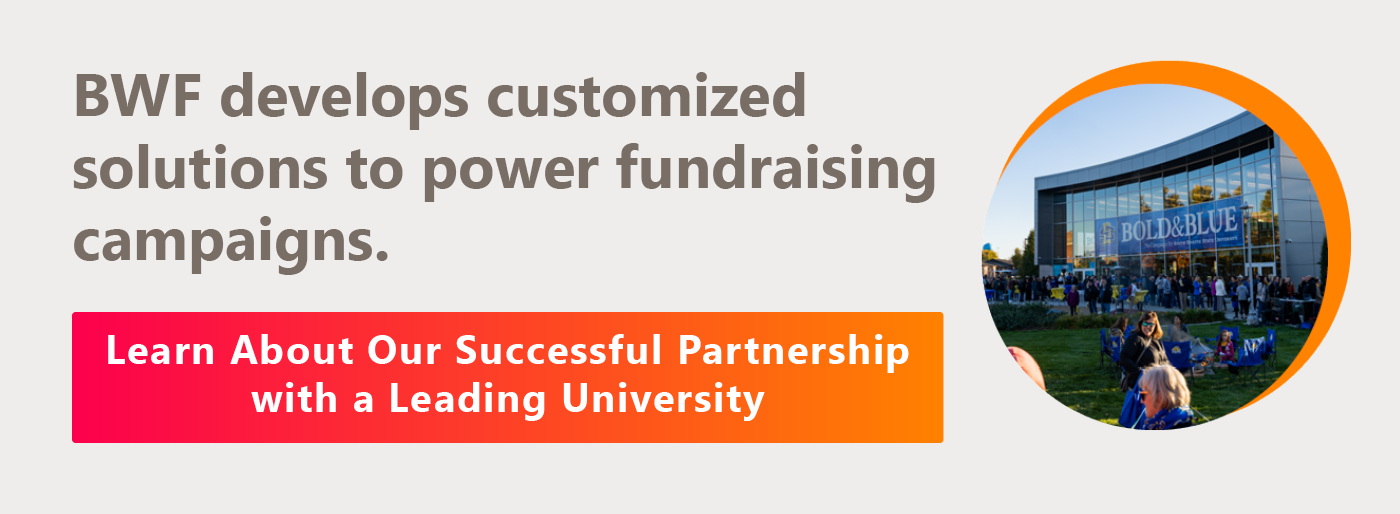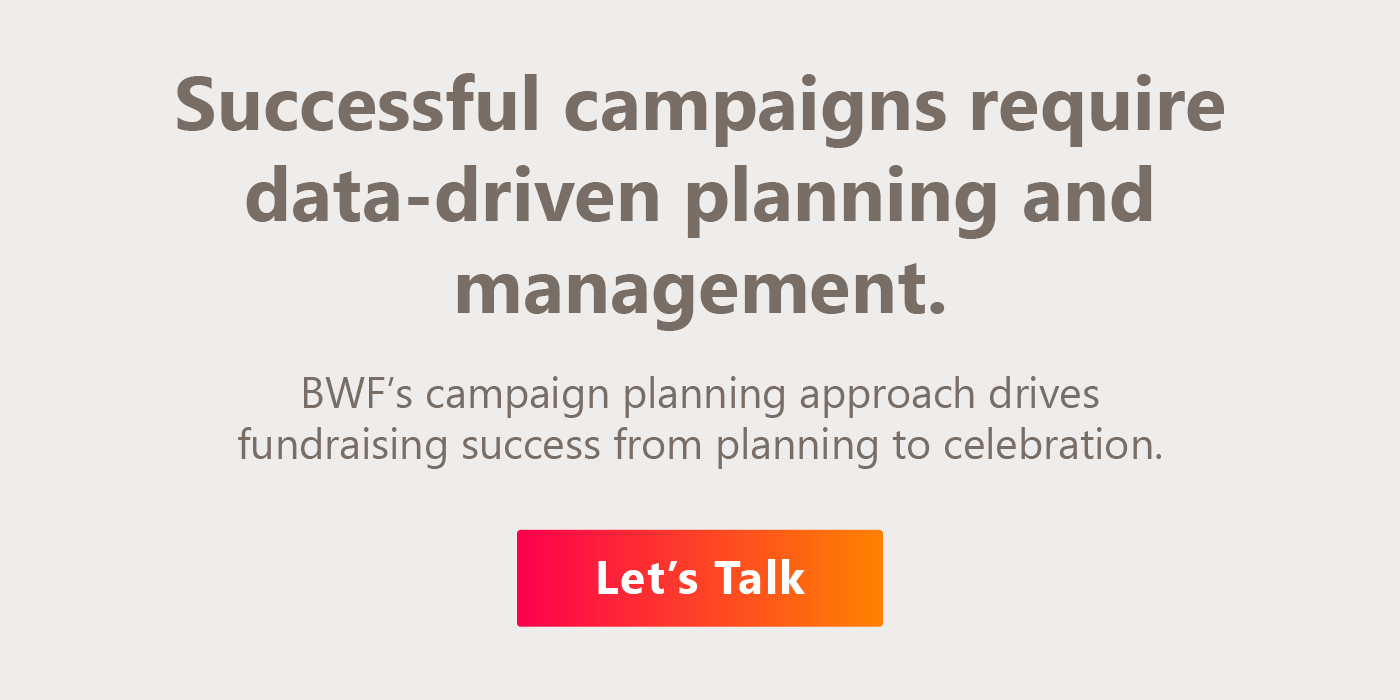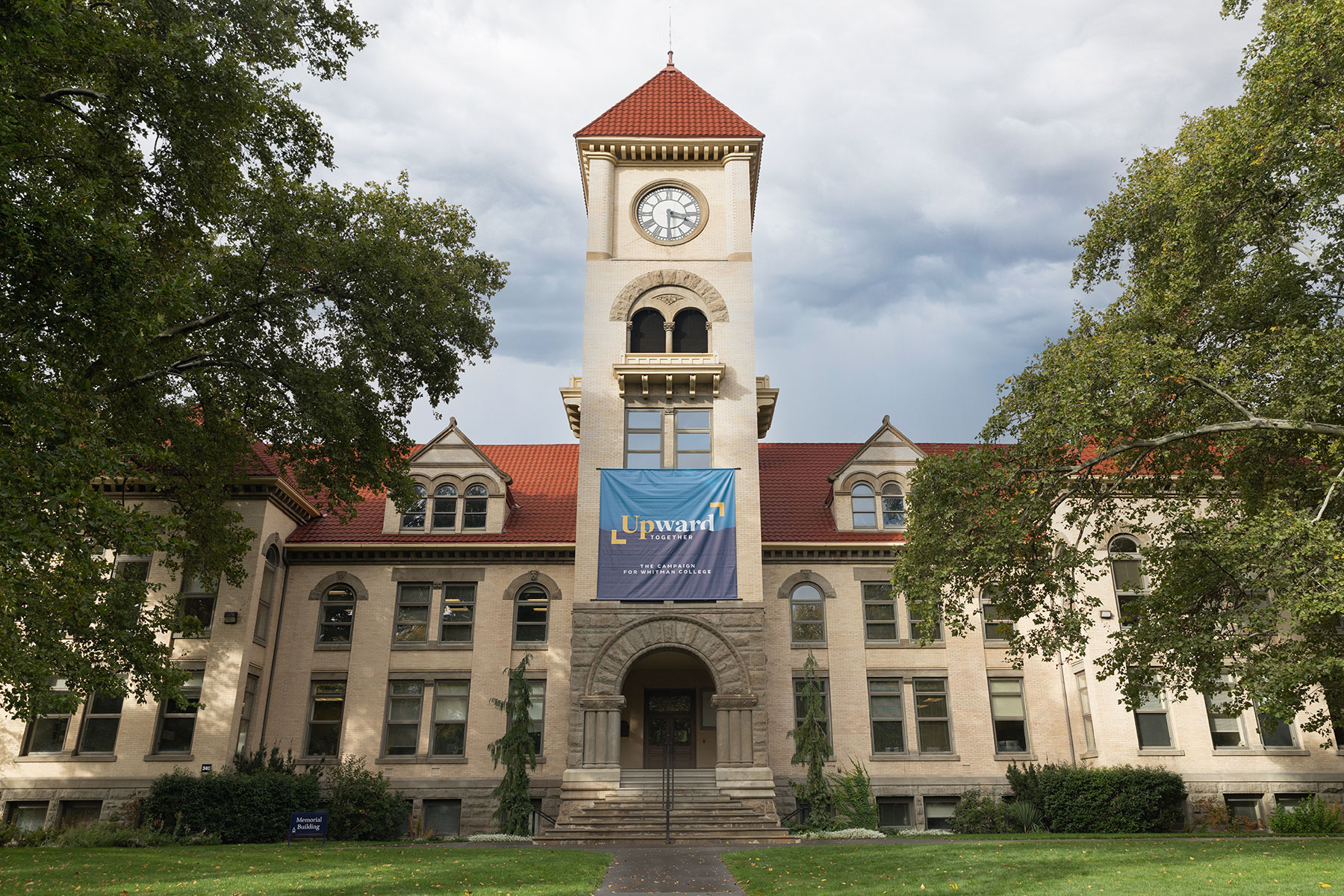Conducting a fundraising feasibility study, also known as a campaign planning study, is a crucial first step for any major campaign. These studies engage stakeholders central to your campaign’s success to determine the viability of your plans. With proper planning, feasibility studies will shed light on an achievable campaign goal.
This guide will explore what you need to know to conduct an effective feasibility or campaign planning study:
- What is a Fundraising Feasibility Study?
- Why Should Organizations Conduct Fundraising Feasibility Studies?
- 8 Steps to Conduct a Successful Feasibility Study
- BWF’s Specialized Approach to Campaign Planning
Let’s start by defining feasibility studies and outlining how they can support your organization’s ambitious fundraising goals.
What is a Fundraising Feasibility Study?
Fundraising feasibility studies or campaign planning studies involve conducting research and surveying stakeholders to determine the practicality and scope of a major campaign, such as a capital or comprehensive campaign. They aren’t just a nice-to-have resource—they are central to the campaign planning process because they prepare your fundraising team and community for a major campaign.
Mark Marshall, Chief Strategy Officer and Co-Owner of BWF, says it best:
“Campaigns create success and multiple campaigns create greater success. However, conducting campaigns in the right way is what will enable them to have the greatest payoff to the institution or organization. While each organization has unique challenges and opportunities, the consistency of capacity building through campaigns is obvious.”
A campaign planning study is one important tool at your disposal to support your capacity-building efforts and lead to the greatest payoff for your mission.
Why Should Organizations Conduct Fundraising Feasibility Studies?
What makes feasibility studies so pivotal to the campaign planning process? Conducting a study allows you to:
- Determine if it’s the right time to launch a major campaign or if you need to return to the drawing board.
- Gauge donors’ interest in your campaign.
- Gather feedback from key stakeholders on important campaign aspects such as your case for support, the purpose of your campaign, or your fundraising goal.
- Determine your community’s capacity to support your campaign financially.
- Set a reasonable but ambitious campaign goal based on past campaigns and your community’s projected giving.
- Establish a timeline for your campaign.
Essentially, campaign planning studies lay the groundwork for successful campaigns. The insights you gather from this process will inform the rest of your campaign, building a clear blueprint for engaging community members and reaching fundraising goals.
8 Steps to Conduct a Successful Feasibility Study
What does a campaign planning study actually look like? Generally, feasibility studies include the following steps:
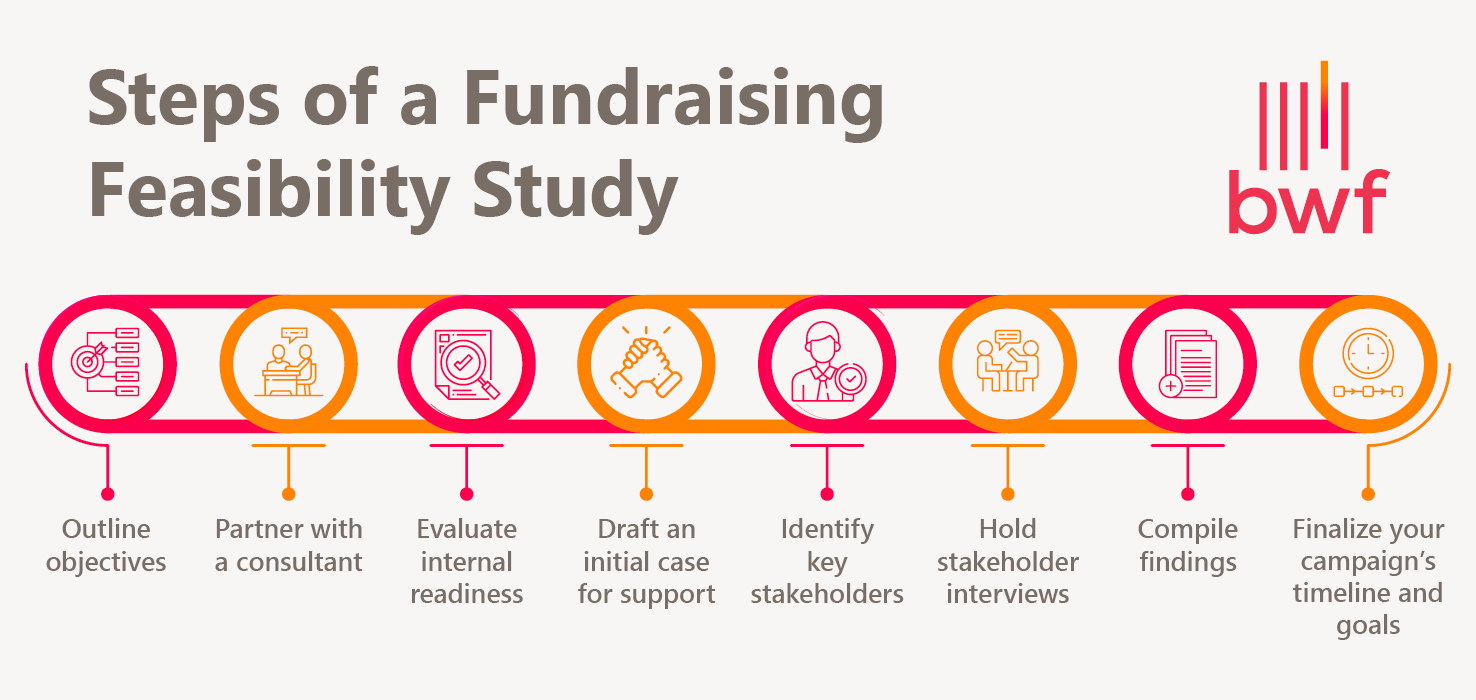
1. Outline the objectives of your campaign planning study.
Approaching the research process with a clear understanding of what you hope to achieve will help make the most of your feasibility study. For example, you could set the following goals for your feasibility study:
- Inform stakeholders about your potential campaign and get clear feedback from them
- Understand the strategic changes you must make before launching your campaign
- Decide whether to move forward with your campaign or revisit it later
- Refine your campaign goal
- Finalize your campaign’s case for support
Ensure all fundraising team members involved in your feasibility study are informed of your goals and can communicate them effectively to other stakeholders.
2. Establish a partnership with a campaign planning consultant.
A campaign planning consultant is a professional fundraising expert who helps carry out your feasibility study.
Working with an unbiased, third-party consultant can lead to more honest answers as you interview stakeholders during your campaign planning study. That’s because stakeholders will be less likely to adjust their responses when speaking to someone they don’t have a pre-existing relationship with.
As you look for a consulting firm to work with, prioritize partners that:
- Have worked with similar organizations in the past
- Offer tailored, customized solutions based on your organization’s needs
- Have proven results from working with a variety of clients
In addition, consider seeking a consultant who can act as a supportive partner throughout your entire campaign. Establishing a working relationship from the beginning of the process allows your consultant to get to know your organization and goals on a deeper level. They can use the insights from your feasibility study to provide reliable support throughout the rest of your campaign.
3. Evaluate internal readiness.
Internal readiness is a measure of your organization’s preparedness to launch a major fundraising undertaking. Assessing internal readiness early in the feasibility study process allows you to ensure that your staff, tech solutions, volunteers, and other internal resources and stakeholders are set up to take on a major campaign.
To evaluate internal readiness, review your organization’s:
- Structure. Is your staff structured in a way that will allow you to assign clear campaign roles and responsibilities? Is there a clear chain of command and accountability, from your executive director through your part-time staff and volunteers?
- Fundraising strategies. Do you have multiple, diverse revenue streams? Are your finances in a stable place? Do you have reliable major donors and sponsors who would support your campaign?
- Communication tactics. Conduct a SWOT (strengths, weaknesses, opportunities, and threats) analysis for your current communication strategies. Do your messages (emails, social media posts, letters, postcards, etc.) see high levels of engagement from audience members? What are your most effective communication channels?
- Messaging. Is your brand cohesive? Can you communicate your mission clearly and concisely? Do your messages resonate with your target audience? Are your materials clearly branded to your organization?
- Analytics processes. Are your fundraising predictive models up to date? Do you need to adjust them in response to audience changes or new data sources? Are there any changes you need to make to your overall process?
- Staff and opportunities for development. Are your staff members trained in current fundraising and communications best practices? Are there opportunities to level up your staff’s skills through training? How thorough are your onboarding materials?
Compare your performance to similar organizations and industry standards with the help of an experienced consultant. For example, BWF offers program assessment and optimization services to evaluate your programs, policies, and processes. We then contextualize them by comparing them to other organizations and industry best practices and develop a tailored plan to improve internal readiness.
4. Draft an initial case for support.
According to BWF’s campaign survey, 17% of respondents identified the articulation of the case for support and vision for the organization as the top success factors for their campaigns. Develop your case for support to give donors, corporate sponsors, and other stakeholders the compelling reasons why they should financially support your campaign.
It should include the following:
- The purpose of the campaign and its anticipated impact on your mission. For example, perhaps your campaign will support constructing a new building on your university’s campus or starting a new program at your nonprofit. The results of these projects could be an enhanced ability to serve your community.
- Your fundraising goal and the role of donations. Supporters should understand how much you need to raise to accomplish your objectives and how their financial contributions will fit into the puzzle.
- How community members can get involved in other ways to support the campaign. Let supporters know additional ways to get involved, such as by volunteering or spreading the word about the campaign to their peers.
At this stage, your case for support will be a rough draft. Throughout the feasibility study, you can ask key stakeholders to review the document and provide feedback to make it more compelling. Then, you’ll present the fine-tuned version to a wider audience when your campaign launches.
5. Identify key stakeholders.
During your campaign planning study, you’ll interview key community stakeholders to get their perspective on how they think the campaign will go. These individuals should have an existing relationship with your organization and feel comfortable sharing their input.
The most helpful stakeholders to interview include:
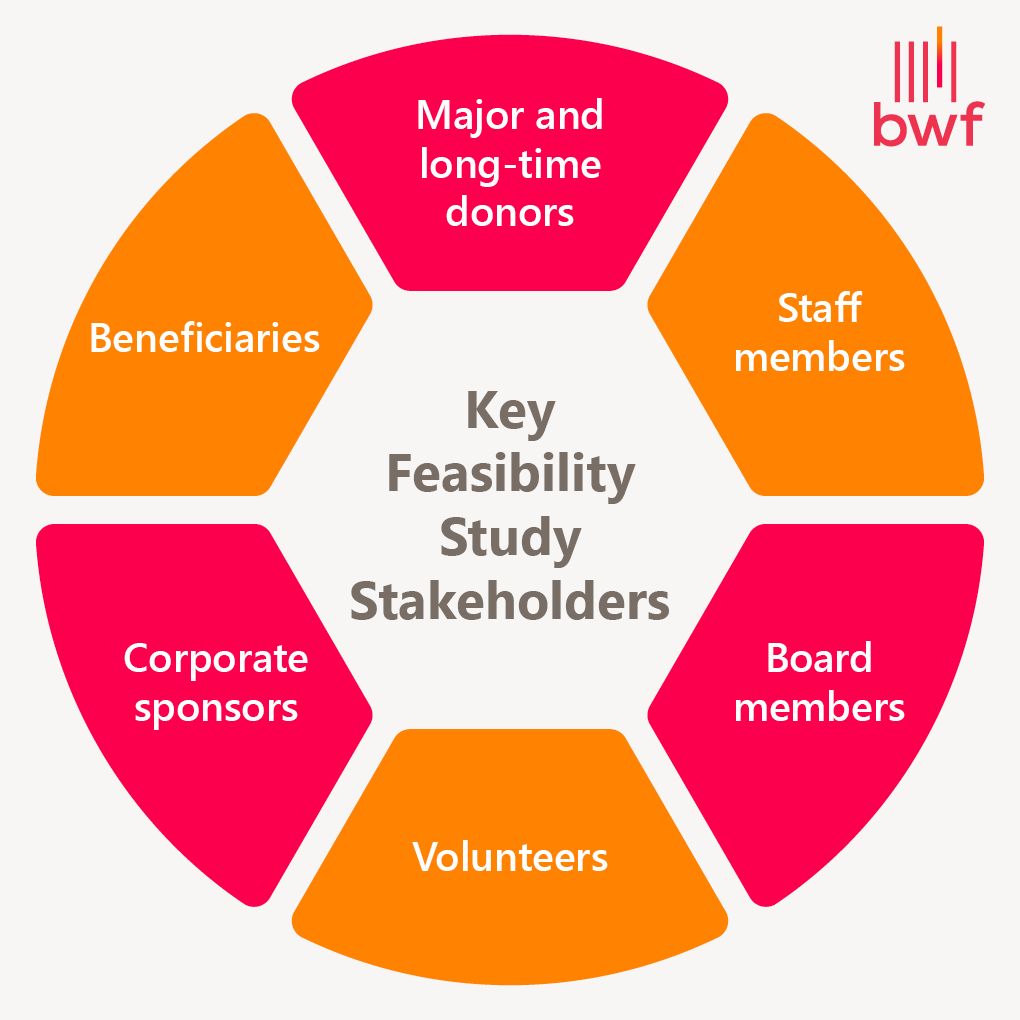
- Major and long-time donors. Donors can let you know if your case for support would encourage them and their peers to give.
- Staff members. Staff members have context for your nonprofit’s fundraising efforts and internal capacity. They may have participated in past campaigns and can provide insight into how those experiences went.
- Board members. Board members are among your nonprofit’s most important leaders. They have context for your nonprofit’s long-term strategic goals.
- Volunteers. Campaigns cannot succeed without volunteer support. Volunteers can offer feedback on the mini-campaigns and events you plan to run throughout your major campaign.
- Corporate sponsors. Corporate sponsors will provide much-needed support during your campaign, whether through direct donations or in-kind gifts. They deserve to give voice to their thoughts on your case for support.
- Beneficiaries. At the end of the day, the reason your organization exists is to serve its beneficiaries. Gather their input on your campaign’s purpose and case for support. Also, use this opportunity to identify beneficiaries interested in playing a larger role in the campaign, such as through sharing their stories.
Stakeholder interviews can also serve as a supporter stewardship tool, as they provide an additional touchpoint for your organization. Plus, supporters will feel like they have a personal investment in your campaign’s success if they helped craft it. That’s why you should reach out to long-time supporters, staff leaders, and passionate corporate sponsors to show that you care about their opinions and want them to participate in your campaign.
6. Hold stakeholder interviews.
During the campaign planning process, you may only have a few minutes to speak with each stakeholder, so choose questions strategically. They should be open-ended, align with your goals, and empower supporters to speak their minds fully.
Ask questions such as:
- Is our case for support compelling? Why or why not?
- What are your first impressions of our campaign goal? Do you think it’s reasonable?
- How likely are you to donate to this campaign?
- Would you be interested in playing a major role during the campaign, such as being a member of the volunteer planning committee?
- What other suggestions do you have for improving our campaign plans?
After conducting stakeholder interviews, thank supporters for their critical role in helping get your campaign off the ground. Also, provide ongoing updates as you wrap up the planning process, review results, and get your campaign underway.
7. Compile your findings and present them to leaders.
Your consultant will compile all survey responses, research, and other findings into a detailed report. Use your report to determine whether your campaign is feasible. Here are some potential outcomes of your study:
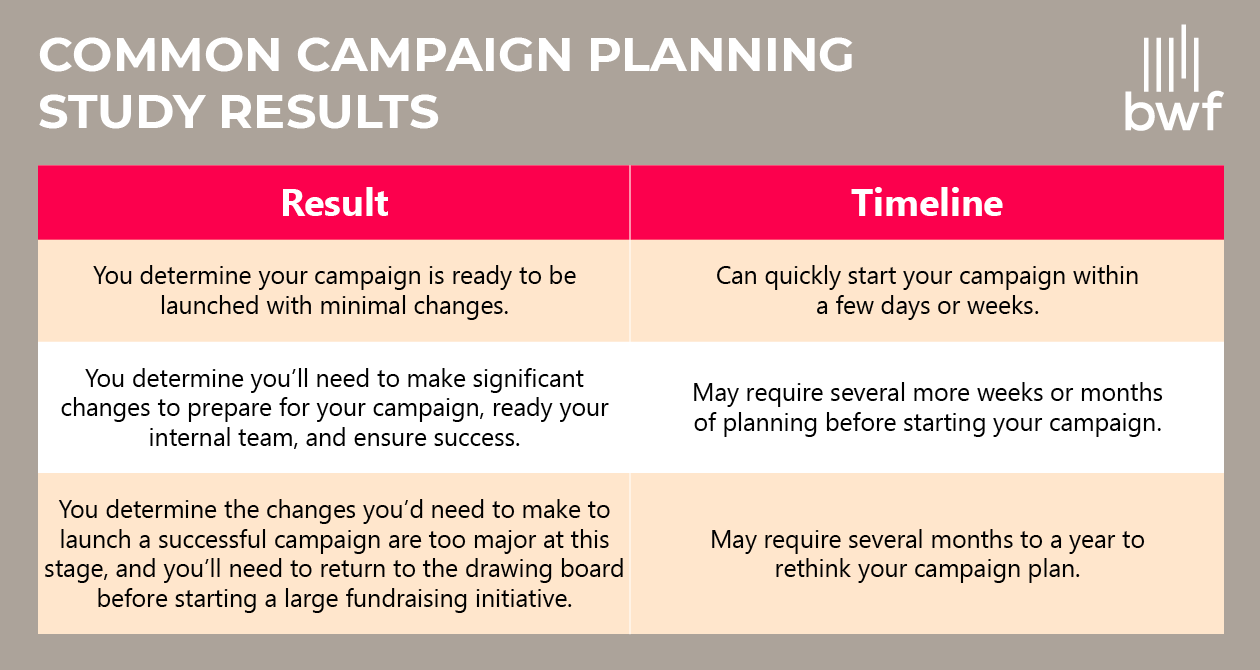
- You determine your campaign is ready to be launched with minimal changes.
- This result will allow you to start your campaign within a few days or weeks.
- You determine you’ll need to make significant changes to prepare for your campaign, ready your internal team, and ensure success.
- This result may require several more weeks or months of planning before starting your campaign.
- You determine the changes you’d need to make to launch a successful campaign are too major at this stage, and you’ll need to return to the drawing board before starting a large fundraising initiative.
- This result may require several months to a year to rethink your campaign
Share the report and findings with your organization’s leadership team. If you need to make adjustments before launching your campaign, use your feasibility study to guide these changes and updates to your strategies.
8. Decide the timeline and goals of your campaign.
If you determine that your organization can begin its campaign, you can immediately start refining and confirming your objectives and timeline.
Finalize the following items:
- Your goals, including your fundraising, donor engagement, and community partnership goals
- Your case for support
- Your campaign timeline
- Your fundraising team roles and responsibilities, including roles for staff members and volunteers
The time you spend fine-tuning your plans and building your internal capacity will be well worth it when you can launch a successful campaign that meets or exceeds your expectations.
BWF’s Specialized Approach to Campaign Planning
If you’re looking for an experienced consultant to help manage your feasibility study, BWF is a trusted partner for many clients in the healthcare, higher-ed, and nonprofit sectors.
Like we say in the video above, we take the approach that we don’t know more than our clients—we know differently. We bring our unique experiences and backgrounds to the table to help support your campaign with a third-party perspective.
In addition, BWF takes a collaborative approach—we’re not creating the solution for you, we’re creating it with you.
We take into consideration your:
- Organizational experience
- Organizational culture
- Unique dataset
With this information, we work with your team to co-create a solution that works best for your unique campaign and goals. Our campaign planning services include:
- Internal readiness assessment
- Campaign planning (feasibility) studies
- Campaign volunteer engagement
- Fundraising strategic planning and data-driven insights
- Campaign management
Clients appreciate that we’re “well-attuned to the dynamic fundraising environment” of their organizations and that we “bring an outside perspective” to identify pitfalls and compare performance to similar organizations.
Wrapping Up
A feasibility or campaign planning study is an exciting first step in the capital or comprehensive campaign process. It can take a lot of work and coordination from your team, but you don’t have to handle it alone. The fundraising campaign consultants at BWF are ready to support your campaign through the entire process.
Looking for more campaign planning resources? Start here:
-
- 8 Steps to Create a Powerful Annual Giving Campaign. Preparing your annual giving plan? This guide will help you determine the best path to raise more this year.
- Comprehensive Campaigns vs. Capital Campaigns: What to Know. A campaign planning study is just one aspect of a major campaign, such as a comprehensive or capital campaign. Here’s what you need to know about these initiatives.
- Campaign Planning and Management. Interested in learning more about BWF’s campaign planning services? Check out the complete list of services here.
Let’s Talk
Find out how BWF can partner with you to conduct campaign planning studies.


